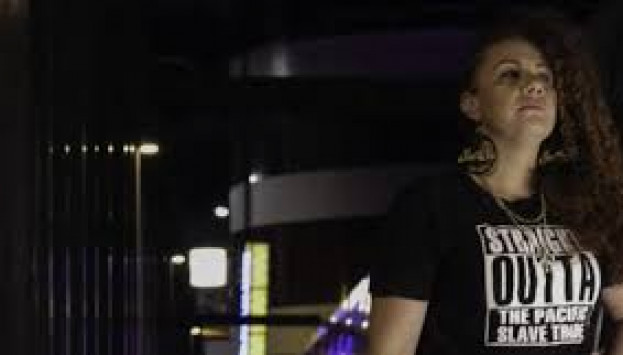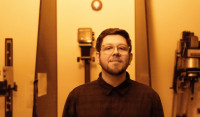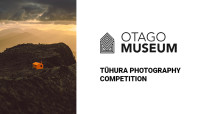THURSDAY SEMINAR PROGRAMME 2 MAY - 13 JUNE, 2019, P152 DUNEDIN SCHOOL OF ART
(image: Jasmine Togo-Brisby: Tautai Artist in Residence) - see 13 June Seminar)
THUR 2 MAY, 12.00 – 1.00 PM, P152, DUNEDIN SCHOOL OF ART, RIEGO ST, DUNEDIN
Rachel Dibble: Lines from within
This 20/20 slideshow is a selection of accumulated experiences in a journey, both symbolically and literally. The autoethnographic journey records the space and time spent traveling to Taranaki Maunga, to Hawera to return whenua ki te whenua and to be close to the tūrangawaewae for the first time with tamariki who have been born away from their marae.
Influenced by the location of the indigenous narrative of Paul Whitinui, spoken word poems and visual (re)defining of words on a page, the journey of the author is literal and metaphorical, discussing the map of the journey, and navigating through a process of whakamaa, while teaching Tiriti o Waitangi as mataawaka. The author is reflecting on the journey and recording the connections made by the author to enrich the connection of her tamariki through whenua ki te whenua.
#turangawaewae #manatamariki #Whenua ki te whenua #roadtripwiththekids #linesonherskin
Ko Rachel Dibble (Ngāti Ruanui, Ngā Ruahine) tōku ingoa. I am a māmā to two tamariki. My mahi at Otago Polytechnic is in Social Services and an annual 'pop up' in Midwifery, focussing on Tiriti o Waitangi application in these areas. The historical links between Taranaki and Ōtepoti have connected me with the landscape that weaves into my teaching and my learning.
_________________________________________________________________________________________________________________
THUR 9 MAY, 12.00 – 1.00 PM, P152, DUNEDIN SCHOOL OF ART, RIEGO ST, DUNEDIN
Lucy Hammond. Space makers: Contemporary approaches to curating collections
This seminar will offer a short overview of the DPAG collection and its history and development, and then discuss curatorial approaches to exhibition making and working with this collection. Lucy will use a series of different exhibitions as case studies, including Space Suit (2018), Gordon Walters: New Vision (2017-18) and Marie Shannon: Rooms found only in the home, discuss more generally the approach to staging exhibitions at DPAG and the role of collaboration in curatorial practice.
Lucy Hammond is a curator and writer based in Ōtepoti/Dunedin. She is the Curator at Dunedin Public Art Gallery, with research interests extending across contemporary and historic art, craft and design. Recent curatorial projects include New Networks: Contemporary Chinese Art (2018-19), Gordon Walters: New Vision (2017-18), and Marie Shannon: Rooms found only in the home (2017). She is widely published,, and a contributing writer to the 2017 publication Gordon Walters: New Vision, which was shortlisted in the Ockham New Zealand Book Awards and winner of the AAANZ 2018 Best Large exhibition catalogue. She is a judge for the illustrated non-fiction category in the 2019 Ockham New Zealand Book awards, and is presently working across a range of contemporary and historic projects in her role at DPAG.
_________________________________________________________________________________________________________________
THUR 16 MAY, 12.00 – 1.00 PM, P152, DUNEDIN SCHOOL OF ART, RIEGO ST, DUNEDIN
Andrew McStay: How To Live Well with Emotional AI: Creativity
Emotions are inextricable from human experience and sit at the heart of artistic production. This seminar discusses and invites conversation on emotional AI, or technologies that use affective computing and artificial intelligence techniques to sense, learn about and interact with human emotional life. Drawing on ongoing research and collaborative work with electronic artist Ronan Devlin, McStay will outline what emotional AI technologies are, how we may theorise these, and ways in which they may be used by artists and creative practitioners. The second part of the seminar will collaboratively address what it means to sense and interact with emotion, opportunities for artists, ethical concerns about use of such data, and what creativity means in context of automated production and AI.
Andrew McStay is Professor of Digital Life at Bangor University (UK) and the 2019 William Evans Fellow. This is the second session in the ‘How To Live Well in Emotional AI’ series presented on the Otago campus and organised by The Brandbach, the creative industries specialisation of the University of Otago.
_________________________________________________________________________________________________________________
THUR 23 MAY, 12.00 – 1.00 PM, P152, DUNEDIN SCHOOL OF ART, RIEGO ST, DUNEDIN
Alex Monteith: The ocean now?
Alex Monteith will present on a range of collaborative works that both she has made, and that the collective Local Time (Danny Butt, Jon Bywater, Alex Monteith & Natalie Robertson) has produced around the coast or about fresh water. The seminar will consider recent art projects that address contemporary coastal living in Moana Nui and Aotearoa in light of emergent eco-tourism economies and recent legal claims on ocean and water. It will also touch on aspects of indigenous/tauiwi partnerships and/or collectivity that have evolved within the works.
Alex Monteith’s works explore the political dimensions of culture in turmoil over land ownership, history and occupation. She is working on a series of artworks focused on bodies of water that evince tensions both historical and natural. These have included an ongoing series on the Rena Disaster (2011-current) in Aotearoa, and a series of work focused on Te Mimi o Tū Te Rakiwhānoa (Fiordland Coastal Marine Area) in relation to recent archaeological history in Aotearoa. Other works traverse political movements, contemporary sports, culture and social activities and projects often taking place in large-scale or extreme geographies. She is also a member of the collective Local Time (Alex Monteith, Danny Butt, Jon Bywater, Natalie Robertson). Local Time has been named as a collective since 2007, usually working in collaboration with maintainers of local knowledge in specific sites, and engaging in debates concerning colonial histories and cross-cultural exchange through art projects, contemporary art teaching and critical writing. Alex is a some-time political and environmental activist.
Exhibitions have included a survey exhibition at the Govett Brewster Art Gallery 2012, and a solo exhibition at MMK Frankfurt, Germany, 2012. Alex was a recipient of the Arts Foundation of New Zealand New Generation Award (2008), and a Walters Prize finalist (2010). She is currently a senior lecturer at the Elam School of Fine Arts, the University of Auckland, Aotearoa, having held prior lecturing positions at AUT (2006) and MIT (2007‐08).
_________________________________________________________________________________________________________________
THUR 30 MAY, 12.00 – 1.00 PM, P152, DUNEDIN SCHOOL OF ART, RIEGO ST, DUNEDIN
Queering the Institutional Space
In this panel discussion, activist Hahna Briggs, artist Sorawit Songsataya and art writer / curator Robyn Maree Pickens will discuss Emma Chalmers' exhibition Intersecting Architectures, on at the Dunedin School of Art from May 20th - May 31st 2019. Emma's exhibition and the attendant publication will consider queer history and culture in Dunedin; the opening up of institutional spaces to the LGBTQI+ community; the connection between sexuality and intersectionality and the potentialities of a utopian queer future (inspired in particular by José Esteban Muñoz’s essay ‘Cruising Utopia: The Then and There of Queer Futurity’).
Hahna Briggs has a Masters in Dance Studies and was the 2013 Caroline Plummer Community Dance Fellow. She currently runs inclusive dance classes and performances for people with and without disability through Gasp! Dance Collective. Hahna has worked for OUSA Student Support for 4 and a half years, first as the Queer Support Co-ordinator and now as the Senior Student Advocate. In addition, Hahna is a member of the Dunedin Pride Inc Management committee.
Robyn Maree Pickens is an art writer, curator and text-based practitioner. Her critical and creative work is centred on the relationship between aesthetic practices and ecological reparation. Robyn's art writing has appeared in Art Asia Pacific online, ANZJA, Art + Australia online, The Pantograph Punch and Art New Zealand. Her most recent curatorial project was presented at Blue Oyster ("Bright Cave" 2018) and her most recent text-based work was exhibited at Te Tuhi (December 2018 - March 2019). Currently Robyn is a PhD candidate in ecological aesthetics at the University of Otago and an art reviewer for the Otago Daily Times and Art News.
Sorawit Songsataya was born in Chiang Mai, Thailand and lives and works in Ōtepoti Dunedin. Primarily interested in craft, textiles, digital modality, handmade and machine-made objects, Sorawit’s practice forms at the intersection of digitised labour and traditional craftsmanship, exploring the intricacy of what it means to “make” today. In 2018 he was awarded the Iaspis Studio Residency, Stockholm, Sweden and the McCahon House artist residency, Tāmaki Makaurau Auckland. In February 2019, Sorawit stayed at the historic Rita Angus cottage as part of Enjoy Public Art Gallery Summer Residency programme. Sorawit has a Master of Fine Art from Elam School of Fine Arts, University of Auckland (2013). Previous exhibitions include Art and Shops, Tensta Konsthall, Stockholm (2018); Bright Cave, Blue Oyster Art Project Space, Ōtepoti Dunedin (2018); Soon Enough: Art in Action, Tensta Konstall, Stockholm (2018); Starling, Artspace, Tāmaki Makaurau Auckland (2018); Acting Out, Adam Art Gallery Te Pātaka Toi, Te Whaganui-a-Tara Wellington (2017); Potentially Yours: The Coming Community, Artspace, Tāmaki Makaurau Auckland (2016); The Non-living Agent, Te Tuhi Centre for the Arts, Tāmaki Makaurau Auckland (2016).
_________________________________________________________________________________________________________________
THUR 6 JUNE, 12.00 – 1.00 PM, P152, DUNEDIN SCHOOL OF ART, RIEGO ST, DUNEDIN
Natalie Smith: From Formality to Fluidity: Fraser Crowe, “Art as Fashion, Fashion as Art” 20 Years On
In 1998 an article on the fashion label Fraser Crowe appeared in Art New Zealand, the title of the article, “Art as Fashion, Fashion as Art: Deborah Crowe and Kim Fraser” spoke to the interchangeability, or fluidity, of the borders and boundaries between the two worlds.
Author, Mark Kirby, noted that Crowe and Fraser’s collaborative designs were considered unusual because they were conceptually based and did not fit “any of the customary fixed fashion categories.” The designs reflected the duo’s backgrounds, Fraser has a background in fashion design, while Crowe has a background in fibre and sculpture. In 1997 Fraser Crowe won the Supreme Award at the Benson & Hedges Smokefree Fashion Design Awards (BHSFDA) for Dual Outlook a garment made from a copper sheath with a woven visor, the design prophetically conceptualised the future – a future where we would need to cocoon ourselves from the onslaught of digital communication. Using Fraser Crowe as a case study this paper explores how, 20 years on, the relationship between art and fashion is now more fluid than ever.
Natalie Smith is a teaching fellow in Sociology, Gender Studies and Criminology and a Lecture in Art History and Visual Culture at the University of Otago. Her primary areas of research interest are New Zealand fashion design and the social and cultural factors that influence design. She is particularly interested in the relationship between gender, work and design; craft; textile design; and the art/fashion nexus. Natalie has a longstanding interest in arts governance and has served on the boards of several not-for-profit arts organizations in Aotearoa New Zealand.
_________________________________________________________________________________________________________________
THUR 13 JUNE, 12.00 – 1.00 PM, P152, DUNEDIN SCHOOL OF ART, RIEGO ST, DUNEDIN
Jasmine Togo-Brisby: Tautai Artist in Residence
Jasmine Togo-Brisby is a fourth-generation Australian South Sea Islander, whose great-great-grandparents were taken from Vanuatu as children and put to work on an Australian sugarcane plantation. Togo-Brisby's research examines the historical practice of 'blackbirding', a romanticised colloquialism for the Pacific slave trade, and its contemporary legacy and impact upon those who trace their roots to New Zealand and Australia through the slave-diaspora. Based in Wellington, Togo-Brisby is one of the few artists delving into the cultural memory and shared histories of plantation colonisation across the Pacific, her practice encompassing painting, early photographic techniques and processes, and sculpture.
Published on 18 Apr 2019
Orderdate: 18 Apr 2019
Expiry: 9 Jun 2019




